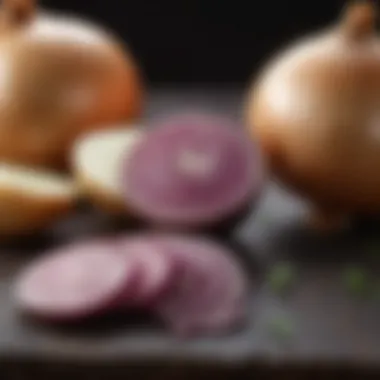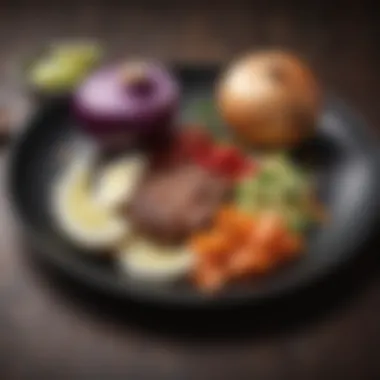Can Diabetics Enjoy Liver and Onions? Nutrition Insights


Intro
Exploring the world of culinary possibilities for diabetics is crucial. A blend of liver and onions significantly raises the question of nutritional compatibility. Both ingredients present intriguing profiles worth dissecting. They also offer potential benefits while preserving flavors and satisfying textures. This section serves as a starting point, setting a framework for an thorough assessment of how these foods align with a diabetic diet.
Recipe Overview
Flavorful Delight: Sautéed Liver with Caramelized Onions
- Portions: Serves 4
- Preparation Time: 15 minutes
- Cooking Time: 20 minutes
- Difficulty Level: Easy
Main Ingredients:
- Beef liver
- Yellow onions
- Olive oil
- Garlic
- Black pepper
- Fresh parsley
This dish employs simple but effective ingredients, making it not only approachable for home cooks but also suitable for diabetic meal planning.
Step-by-Step Instructions
- Prep Ingredients
- Cooking
- Rinse the beef liver under cold water and pat dry with paper towels. Slice liver into strips, about half an inch thick.
- Peel and slice the yellow onions into thin rings.
- Heat two tablespoons of olive oil in a skillet over medium heat.
- Add sliced onions and sauté until they're soft and golden, about 10 minutes. Stir occasionally for even cooking.
- Add minced garlic, and cook for additional minute until fragrant. Push onions to the side of the skillet.
- Increase stove to high heat; add liver strips seasoned with salt and black pepper. Sear them on both sides, cooking around 3 to 4 minutes per side.
- Toss everything together, sprinkle with chopped fresh parsley, and serve.
Time-saving strategy: To make it quicker, you can prep onions in advance or use pre-sliced liver if available.
Nutritional Information
Each serving has approximately:
- Calories: 250
- Proteins: 35g
- Fats: 12g
- Carbohydrates: 6g
The dish is plentiful in iron, vitamin B12, and various other essential nutrients that help balance blood sugar levels while providing substantial energy.
Quick Cooking Tips
- Using a slow cooker can help in preparing onions in batches while caramelizing them slowly over time.
- For a healthier twist, consider using minimal oil or substitute an air fryer for cooking liver and onions. This will reduce fats involved without losing flavor.
- Always ensure that you multitask efficiently. As liver cooks quickly, maintain a close watch to not overdo it.
Related Recipes & Variations
- For simplicity, a Liver Pâté serves as a suitable option with low complexity.
- A side of steamed broccoli could enhance the dish's nutritional value while providing fiber.
- Vegetable stir-fry could easily complement liver; just toast some garlic with seasonal vegetables and arrange them side by side.
Modify the base recipe as needed. The suggestion to swap yellow onions for shallots offers a special twist, presenting a subtler sweetness.
Those managing their blood sugar can still savor delicious meals. Thoughtful ingredients can yield not just comfort but enhance overall dietary diversity.
Understanding Diabetes and Dietary Needs
Diabetes is a prevalent condition that demands careful attention to dietary choices. Understanding the interaction between food and blood sugar levels is crucial for effective management. In this article, we expand on how liver and onions fit into this equation, providing a necessary foundation for making informed eating decisions. Gastronomic enjoyment should not be sacrificed as individuals navigate their dietary restrictions and preferences. Consequently, examining the nutritional interaction of ingredients is imperative to preserving health while enjoying flavorful meals.
What is Diabetes?
Diabetes is a chronic health condition characterized by elevated levels of blood glucose. It occurs when the body either does not produce enough insulin or becomes resistant to it, leading to complications if uncontrolled. There are several forms of diabetes, including Type 1, Type 2, and gestational diabetes. Type 1 diabetes typically arises in childhood as an autoimmune response, while Type 2, more common in adults, is often caused by lifestyle factors. Both varieties necessitate meticulous management, which extends beyond merely counting carbohydrates.


In managing diabetes, understanding glucose and insulin functionality becomes critical. Insulin is a hormone that regulates blood glucose levels, and when its administration or effectiveness is compromised, blood sugar may rise to dangerous levels. Individuals with diabetes often require tailored nutrition regimens that accommodate their unique metabolic responses.
Importance of Diet in Diabetes Management
The role of diet is pivotal in managing diabetes and maintaining overall health. A thoughtful dietary approach can help stabilize blood sugar levels, mitigate complications, and enhance quality of life.
Balanced nutrition focuses on several key elements:
- Glycemic Control: Individuals with diabetes need to be aware of the glycemic index (GI) of foods. It measures the rate at which carbohydrates in food raise blood sugar levels. Foods with low GI scores are generally recommended, as they produce a slower and steadier increase in glucose levels.
- Macronutrient Balance: Careful attention should be directed towards maintaining an ideal mix of carbohydrates, proteins, and fats. This balance assists in sustained energy release and prevents spikes in blood glucose.
- Portion Size Awareness: Monitoring portion sizes helps to manage caloric intake and blood glucose response effectively.
- Nutrient Concentration: Prioritizing foods rich in essential vitamins and minerals contributes to improved health and helps counteract deficiencies common in individuals managing diabetes.
Examining the nutritional profiles of foods regularly included in dietary plans can reveal their effects on health and blood sugar management. With this understanding, incorporating liver and onions can lead toward a well-rounded incorporation in a diabetic meal plan.
Nutritional Profile of Liver
The liver is often regarded as a nutritional powerhouse, packed with vitamins and minerals essential for health. This section aims to illustrate the nutritional profile of liver, its advantages, and what considerations should be kept in mind for those watching their diet, particularly diabetics. Understanding how the liver's nutrients can align with a diabetes-friendly diet is crucial for making informed food choices.
Vitamins and Minerals in Liver
Liver is a rich source of essential vitamins and minerals. It is an abundant source of vitamin A, which is necessary for vision and immune system function. This vitamin plays a role in helping maintain the health of the skin and the lining of organs.
Moreover, liver is high in vitamin B12, necessary for red blood cell formation and neurological function.
Among minerals, iron is a significant component found in liver, particularly heme iron, which is more readily absorbed by the body compared to non-heme iron found in plant-based sources. The liver also contains other essential minerals like zinc and selenium, which contribute to various bodily functions, including antioxidant activity and immune response.
A well-rounded approach to nutrition involves including this powerhouse of vitamins and minerals.
Protein Content and Its Benefits
The protein content in liver is another remarkable feature. Liver provides complete protein, which includes all essential amino acids necessary for the body's repair processes. This could be appealing for diabetics seeking to manage hunger levels and blood sugar responses better. Protein can support satiety, reducing the likelihood of snacking on uncontrolled carbohydrate sources.
Additionally, protein plays a critical role in muscle maintenance and can be especially beneficial when managing weight as part of diabetes care. Even in smaller quantities, the liver can still provide significant protein intake to those mindful of portion sizes.
Fat Content: Saturated vs.
Unsaturated Fats
When it comes to fat, the liver contains a mix of both saturated and unsaturated fats. While liver tends to be moderate in total fat content, it is essential to differentiate between types. Saturated fats might contribute to heart health concerns if consumed in excess, while unsaturated fats are generally viewed as healthier, benefiting cardiovascular health.
For diabetics, managing fat intake forms an essential part of overall dietary strategy. Consuming moderate portions while focusing on cooking methods that minimize excessive fat can align well with diabetic considerations. Opting for preparation techniques that limit added saturated fats can ensure that liver's other health benefits are felt without the drawbacks.
Overall, knowing the nutritional profile of liver can empower individuals. By blending knowledge of its vitamins, minerals, lipids, and proteins smoothly into meal planning, diabetics can confidently include liver in their diets.
Nutritional Profile of Onions
Understanding the nutritional profile of onions is vital for diabetics. Onions offer not only a unique flavor to dishes but also a range of health benefits. Knowing their essential nutrients and how they impact blood sugar can help make better dietary choices.
Essential Nutrients in Onions
Onions contain a variety of nutrients that contribute to overall health. Key components include:
- Vitamins: Onions are a rich source of vitamin C, which aids in the repair of tissues and supports the immune system. They also contain B vitamins, important for energy production.
- Minerals: They have substantial amounts of potassium, which is crucial for heart health. Additionally, calcium and magnesium present in onions can help support bone strength.
- Antioxidants: Onions contain several antioxidants, including quercetin. This potent compound is known for its anti-inflammatory properties and may also assist in regulating blood sugar levels.
Overall, these nutrients combine to support metabolic processes, providing a balanced addition to a diabetic diet.


Glycemic Index of Onions
The glycemic index (GI) is an important measure for those managing diabetes. It indicates how quickly a carbohydrate raises blood sugar levels. Onions have a low glycemic index, typically around 10 to 15, which means they do not cause significant spikes in blood sugar when consumed. This quality makes them suitable for a diabetic diet.
Including onions in meals can enhance satiety while keeping blood glucose levels stable. As a result, onions can complement other foods without substantially impacting overall glycemic response.
The Compatibility of Liver and Onions in a Diabetic Diet
When considering a person with diabetes, the compatibility of liver and onions in their diet brings up essential discussions about nutritional value and blood sugar management. Combining these ions carries health benefits. Yet, understanding how they play a role in overall wellness is vital. This section investigates factors such as glycemic impact, nutrient content, and effects on blood sugar levels. Evaluating these components helps establish whether it is safe for diabetics to include liver and onions without adverse changes in health.
Blood Sugar Impact of Liver and Onions
The impact of stated foods on blood sugar levels is of utmost importance for diabetics. Liver is indeed low in carbohydrates, minimizing its direct influence on glucose levels. This can justify its place in a healthy diabetic diet, especially when you're mineral and vitamin needs are crucial for overall health.
Onions, on the other hand, are often portrayed more benignly; they have a low glycemic index rating, mostly hovering around 10. By being higher in fiber and lower in calories, onions can also aid in blood sugar management by slowing digestion. Plus, the sulfur compounds present in onions can potentially contribute to better insulin sensitivity.
Research supports the notion that combining these foods may provide a more balanced pathology for blood glucose levels.
“A low glycemic index diet using foods like liver and onions provides more stable energy levels without causing steep spikes in blood sugars.”
Portion Control Recommendations
Yet, despite the arguments above, quantity plays a significant role. It is recommended to implement (controlled serving sizes to avoid the risk of potential spikes in blood sugars and other harmful consequences. The following serve as general guidelines:
- Liver Serving Suggestions: For most individuals, a serving size of approximately 3 to 4 ounces is advisable. This provides sufficient nutrients without overwhelming the system with excess vitamin A or cholesterol.
- Onion Portions: Generally, one medium onion when diced or cooked, divided across meals, will not have a meaningful impact, provided one exercises moderation when mixing with other carbohydrate-containing foods.
Finding a balance plays a crucial role; too big portions from anything can lead tissues and cells struggle under excess demands.
Integrating these products, combined with continual monitoring will lead you to sensible choices, underscoring the essential believe: any item considered compatible in the diet's framework should revolve around moderation and intention.
Cooking Methods for Liver and Onions
Cooking methods play a crucial role in determining the healthfulness and safety of liver and onions in a diabetic diet. The right cooking technique not only influences the flavor and texture of the dish but also impacts the nutritional profile. Diabetics need to be particularly mindful of how foods are prepared, as certain methods may introduce excessive fats or sugars, undermining dietary restrictions.
Opting for healthier cooking methods can enhance the benefits of liver and onions. This section will explore common techniques, as well as healthier options, to ensure that the dish remains both nutritious and enjoyable. Understanding these cooking methods is essential for individuals who want to include liver and onions in their diet without compromising their health.
Common Cooking Techniques
Cooking liver and onions can be performed using various methods, each with its unique considerations. The most frequently used techniques include:
- Sautéing: This method is popular for preparing liver and onions. It allows for quick cooking, preserving the flavors. However, it often involves adding butter or oil, which can increase caloric content. It's important to select oils wisely, favoring options like olive oil for improved health benefits.
- Grilling: A healthier option that can add distinctive flavor. Grilling can render out excess fat in the liver, making it a leaner choice. Seasoning the liver and onions minimally can keep the blood sugar impact lower.
- Braising: This slow-cooking method enhances flavor and tenderness. However, braising usually requires moisture, which could involve sugars in marinades. Adequate attention is necessary to the ingredients in the marinade.
- Broiling: This technique provides a way to cook without much added fat, as the high heat cooks the food rapidly. When both liver and onions are broiled, losing excessive fat is beneficial for health.
Each of these methods has benefits and drawbacks, but the right choice can improve the overall quality of the meal, particularly for diabetics who need to manage their dietary intake carefully.
Healthier Preparation Options
Incorporating liver and onions into a diet while maintaining health consciousness can be achieved through some strategic preparation choices. Here are some healthier options:
- Use of Low-Fat Cooking Spray: Instead of butter or oil, consider using a spray to reduce the amount of fat without sacrificing taste.
- Marinate with Herbs and Spices: To impart flavor, use fresh herbs and spices rather than sauces that are high in sugar and sodium. Garlic, thyme, and rosemary complement both liver and onions well.
- Cooking Timing and Temperature: Be mindful of cooking times to avoid overcooking the liver, which can make it tougher and less pleasant to eat. Slow but gentle cooking methods preserve both flavor and the nutritional profile.
- Control Portions: When preparing liver, controlling the size of the portion helps keep calories lower. Pairing with a generous serving of onions boosts flavor while offering fiber that may help with blood sugar control.
Remember, making a healthful choice in cooking techniques can help diabetics enjoy liver and onions without compromising their health goals.
For further reading about cooking techniques, refer to sources like Wikipedia or explore culinary guides on Britannica to expand your understanding of healthful cooking principles.


Potential Health Benefits of Liver
Liver is not just a rich source of flavor but also presents numerous health benefits that can be especially valuable for people managing diabetes. The nutrient density of liver often gets overlooked in modern diets, mainly due to fat content concerns and misconceptions surrounding organ meats. When looked at in a balanced manner, liver can be a beneficial inclusion in a diabetic's diet, provided that one is aware of portion sizes and preparation methods.
Nutritional Benefits Beyond Diabetes
Liver provides several vitamins and minerals essential for all individuals. These nutrients extend beyond what is traditionally emphasized in diabetic diets. The liver is a standout in its supply of Vitamin A, which plays a major role in maintaining healthy vision and skin health. Furthermore, it is packed with B vitamins including B12 and folate. B12, critical for neurological function, may be particularly relevant as individuals with diabetes often face nerve issues.
The liver also offers substantial amounts of copper and zinc. These trace minerals help in optimizing immune function and support overall metabolism. Such nutrients can counteract some of the comorbidities often associated with diabetes, potentially providing a health safeguard for diabetic individuals.
In essence, the inclusion of liver as part of a balanced diet promotes better health outcomes and enhances nutritional profiles. Although the main focus may remain on glycemic control, diversified nutrient intake is equally important for overall wellness.
Natural Sources of Iron
One of the most significant aspects of liver is its elevated iron content. Iron is crucial for forming hemoglobin, which plays an essential role in transporting oxygen throughout the body. For diabetics, maintaining adequate iron levels can help strengthen overall vitality and counter issues like fatigue that can arise when also potentially experiencing low sugar levels.
Liver iron is primarily in the form of heme iron, which is more absorbable than non-heme iron found in plant sources. This makes liver an attractive option for ensuring sufficient iron intake, especially during periods when absorption from other sources may be insufficient or compromised.
A practical way to focus on iron intake is to consider incorporating liver weekly, depending on dietary preferences and restrictions. Combining it with vitamin C-rich vegetables can aid absorption and maximize benefit.
Incorporating liver into a diabetic diet not only adds depth of flavor but also enhances nutritional adequacy, offering key vitamins and iron that can address broader health needs.
By appreciating the potential health benefits of liver, those managing diabetes may find a flavorful and secure path toward achieving dietary goals.
Considerations for Including Liver and Onions in a Diet
When incorporating liver and onions into a diabetic diet, several important factors need attention. These considerations can influence not just blood sugar levels, but overall health and enjoyment of the meal. Both of these foods can offer unique adaptations to a diabetic-friendly diet, but recognizing individual needs is crucial.
Consulting Healthcare Professionals
Before adding liver and onions to a meal plan, it is wise to consult healthcare professionals. Doctors or certified dietitians can provide personalized guidance that factors in individual health status, medications, and personal dietary restrictions.
Liver is nutrient-rich, but its high levels of vitamin A can pose risks if consumed in excess. For instance, diabetics on certain medications may need to limit vitamin A intake. By consulting with a healthcare provider, it allows for a balanced approach, limiting potential adverse effects while enabling the enjoyment of flavorful dishes.
Furthermore, healthcare professionals may introduce testing strategies that help monitor blood sugar levels in relation to new dietary practices. With their insights, individuals will feel more confident about their choices.
Allergies and Sensitivities
Inclusion of liver and onions in a diet also requires listening to one’s body regarding allergies and sensitivities. Some individuals might be allergic to specific meats or have intolerances to certain substances in food. Although rare, liver can trigger allergic reactions in susceptible individuals, announcing itself through gastrointestinal distress or skin reactions.
Onions, on the other hand, may not be suitable for some diabetics due to possible digestive issues, exacerbating conditions such as irritable bowel syndrome or familial Mediterranean fever. It is essential to be aware of one’s reactions to these foods.
Summary
- Consult professionals: Getting assistance from healthcare providers aids in creating a tailored diet.
- Monitor reactions: Watch for any symptoms after consuming liver or onions.
Exploring these considerations significantly enriches the practice of integrating liver and onions into meals for diabetics, informing a thoughtful approach to food choices.
Culmination
Final Thoughts on Liver and Onions for Diabetics
A few things must be considered when including liver and onions in a meal plan.
- Nutritional Assets: Together they deliver proteins, high-quality vitamins, and minerals, which are crucial for overall health. The read-only qualities of liver and onions make it a beneficial addition when consumed in moderation.
- Portion control is significant: It's not just about what you eat but how much you eat. Diabetics should focus on portions that adequately manage their intake of calories, carbohydrates, and fats to keep blood sugar levels stable.
- Consulting with Nutritionists: Individuals with diabetes are encouraged to work closely with healthcare professionals to design a balanced diet that incorporates nutrients without compromising dietary goals.
- Monitoring Blood Sugar Levels Regularly: Tracking glucose responses after meals can aid in adjusting serving sizes or meal frequencies, creating a balanced start for meal customization.
Incorporating liver and onions into a diet may provide dieters with adequate nutrition if handled correctly. By understanding best practices and portioning guidelines while also enjoying these foods' tasted and health benefits, diabetics can expand their culinary horizons without sacrificing health needs. Ultimately, it’s about balance.
"Balance in diet leads to harmony in health."







